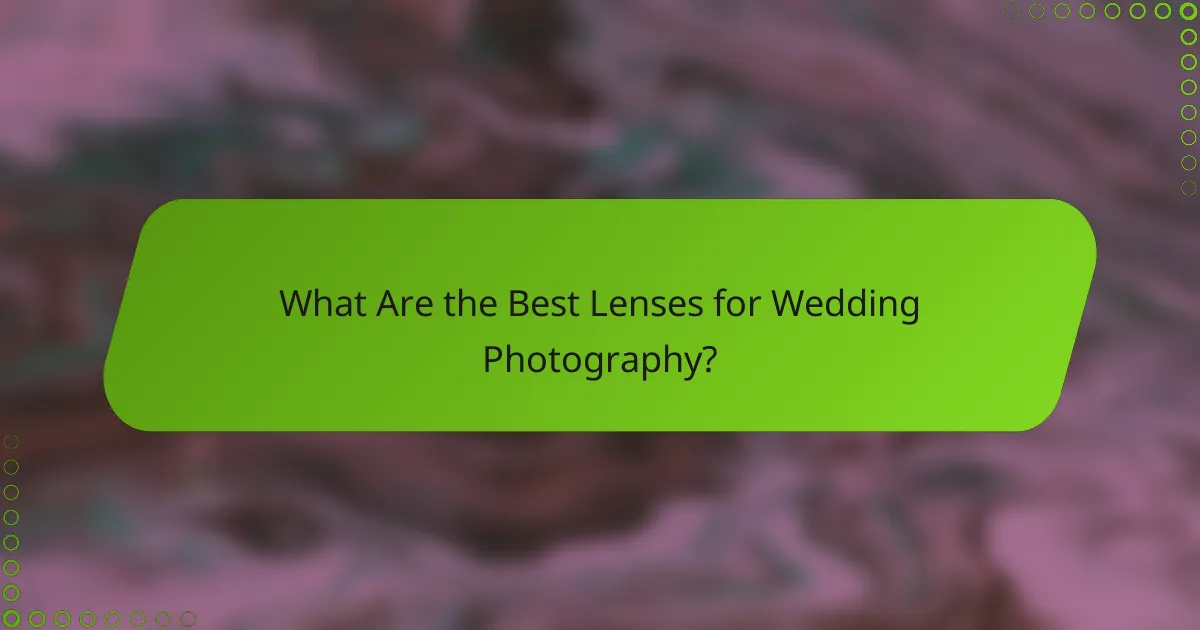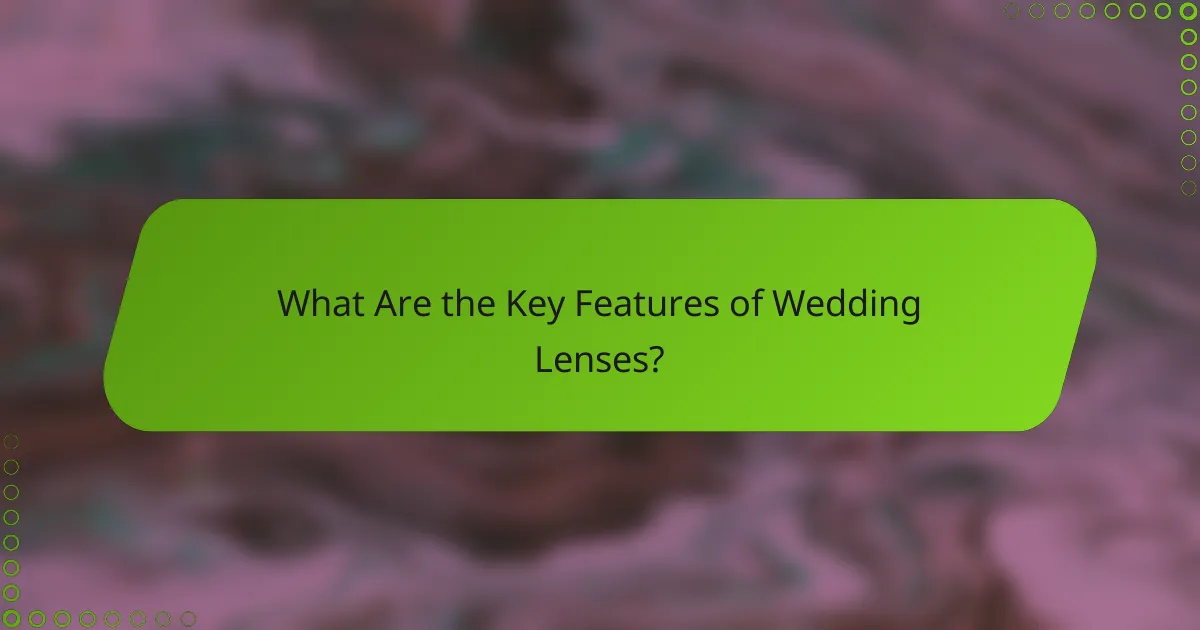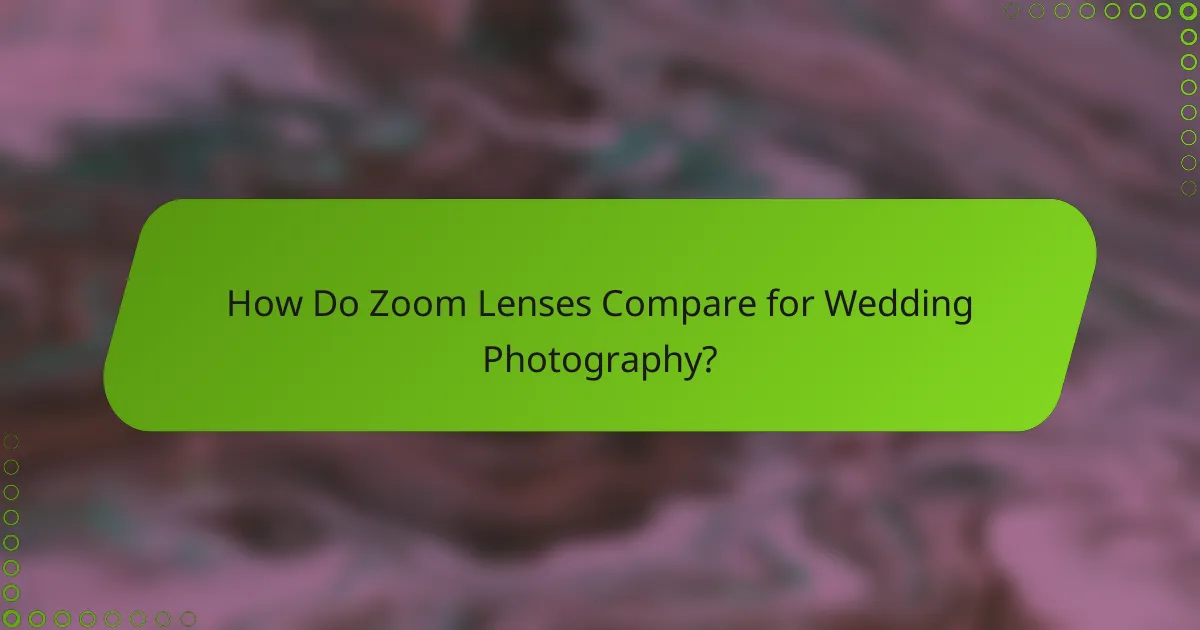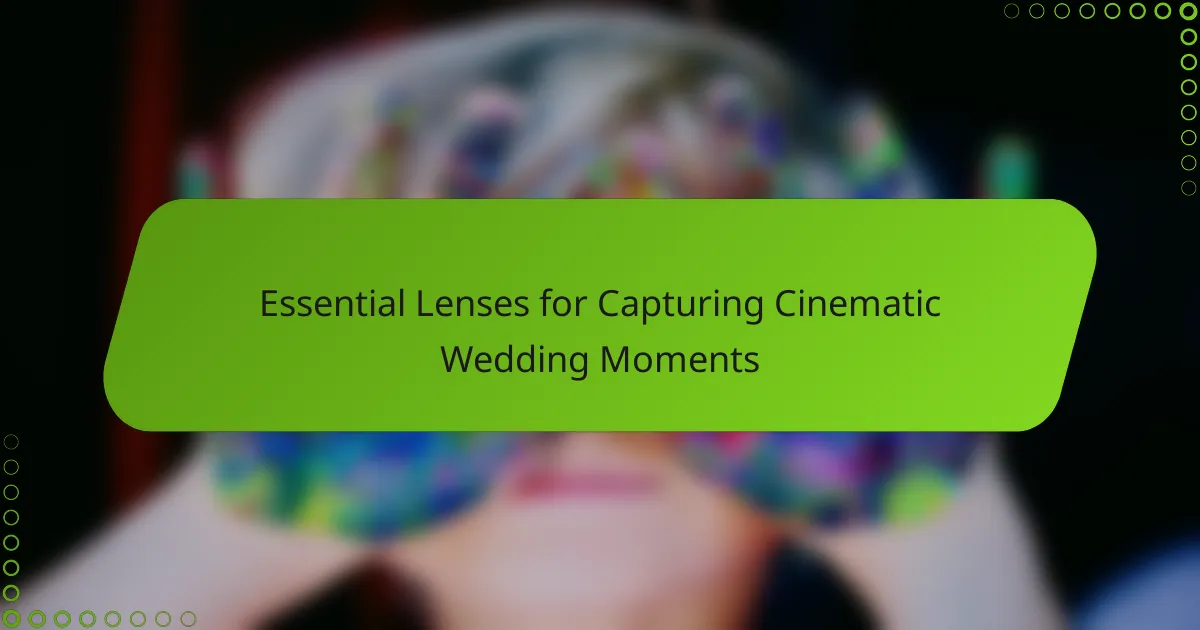Capturing cinematic wedding moments requires the right lenses that offer versatility, sharpness, and excellent low-light performance. Prime lenses are ideal for stunning portraits, while zoom lenses allow for flexibility in various scenes without the need to frequently change equipment. Prioritizing features like image stabilization and fast autofocus will enhance your ability to document these special occasions beautifully.

What Are the Best Lenses for Wedding Photography?
The best lenses for wedding photography are those that provide versatility, sharpness, and excellent low-light performance. Key options include prime lenses for portraits and zoom lenses for capturing various scenes without changing equipment frequently.
Canon EF 50mm f/1.2L
The Canon EF 50mm f/1.2L is a prime lens known for its stunning bokeh and low-light capabilities. This lens excels in creating beautiful portraits with a soft background, making it ideal for intimate wedding moments.
When using this lens, consider its wide aperture, which allows for faster shutter speeds in dimly lit venues. However, be mindful of its depth of field, as focusing can be tricky if the subject is moving.
Nikon AF-S 85mm f/1.4G
The Nikon AF-S 85mm f/1.4G is a favorite among wedding photographers for its flattering compression and sharpness. This lens captures stunning portraits with excellent detail, making it perfect for bride and groom shots.
Its fast aperture helps in low-light situations, but it’s best used at a distance to avoid crowding the couple. Ensure you have enough space to frame your subjects without distortion.
Sony FE 24-70mm f/2.8 GM
The Sony FE 24-70mm f/2.8 GM is a versatile zoom lens that covers a wide range of wedding scenarios, from wide-angle group shots to close-up details. Its constant f/2.8 aperture provides consistent performance in various lighting conditions.
This lens is particularly useful for capturing candid moments without needing to switch lenses frequently. However, be aware that it can be heavier than prime lenses, which may affect mobility during long events.
Fujifilm XF 56mm f/1.2 R
The Fujifilm XF 56mm f/1.2 R is an exceptional lens for portrait photography, offering a beautiful depth of field and sharp images. This lens is perfect for capturing the emotions of the day, from vows to first dances.
Its large aperture allows for stunning low-light performance, but be cautious of its shallow depth of field. Practice focusing techniques to ensure you capture those fleeting moments perfectly.
Panasonic Lumix 25mm f/1.7
The Panasonic Lumix 25mm f/1.7 is a compact and lightweight lens that delivers excellent image quality for wedding photography. Its fast aperture makes it a great choice for low-light situations, allowing for creative shots during receptions.
This lens is budget-friendly, making it accessible for amateur photographers. However, its focal length may require you to move around more to frame shots effectively, so be prepared to stay mobile throughout the event.

How to Choose Lenses for Cinematic Wedding Shots?
Choosing the right lenses for cinematic wedding shots is crucial for capturing stunning visuals. Focus on focal length, aperture size, and compatibility with your camera body to ensure you achieve the desired cinematic effect.
Consider focal length
Focal length significantly influences the composition and perspective of your wedding shots. For wide-angle shots, consider lenses in the 16mm to 35mm range, which are ideal for capturing large groups and expansive venues.
For portraits and detail shots, a focal length between 50mm and 85mm is often preferred, as it provides a flattering perspective without distortion. Telephoto lenses, ranging from 70mm to 200mm, are excellent for candid moments from a distance.
Evaluate aperture size
Aperture size affects the depth of field and the amount of light entering the lens. A larger aperture (e.g., f/1.8 to f/2.8) is beneficial for low-light conditions typical in wedding venues, allowing for beautiful bokeh and subject isolation.
However, smaller apertures (e.g., f/4 to f/8) can be useful for group shots and landscapes, ensuring more of the scene is in focus. Balance your lens choices based on the lighting conditions you expect during the event.
Assess compatibility with camera body
Ensure that the lenses you choose are compatible with your camera body to avoid functionality issues. Check the lens mount type and sensor size; for example, full-frame lenses work best with full-frame cameras, while crop sensor cameras may require specific lenses for optimal performance.
Additionally, consider the autofocus capabilities and image stabilization features of the lenses, as these can enhance your shooting experience and improve the quality of your wedding footage.

What Are the Key Features of Wedding Lenses?
Wedding lenses should have essential features that enhance image quality and adaptability to various conditions. Key features include image stabilization, weather sealing, and fast autofocus, all of which contribute to capturing stunning moments during a wedding.
Image stabilization
Image stabilization (IS) is crucial for wedding photography, especially in dynamic environments. It helps reduce blurriness caused by camera shake, allowing for sharper images even in low-light situations or when shooting handheld.
When choosing a lens, look for those with optical or in-body stabilization. Optical stabilization is typically more effective for still images, while in-body systems can assist with video. Consider lenses with IS ratings that indicate their effectiveness, as this can vary significantly.
Weather sealing
Weather sealing is an important feature for wedding lenses, particularly for outdoor ceremonies or receptions. Lenses with weather sealing are designed to resist moisture and dust, ensuring they function well in unpredictable weather conditions.
When selecting a lens, check for an IP rating or manufacturer specifications that confirm its weather-resistant capabilities. This feature can be invaluable during outdoor events, where sudden rain or humidity might occur.
Autofocus speed
Fast autofocus speed is essential for capturing fleeting moments during weddings. A lens with quick and accurate autofocus allows photographers to react swiftly to spontaneous events, ensuring that no precious moment is missed.
Consider lenses that feature advanced autofocus technologies, such as ultrasonic motors or linear motors, which provide faster and quieter focusing. Testing the autofocus speed in real-world scenarios can help determine if a lens meets your needs for wedding photography.

What Are the Advantages of Prime Lenses for Weddings?
Prime lenses offer several advantages for wedding photography, including superior image quality and enhanced low-light capabilities. Their fixed focal lengths encourage creativity and help photographers capture stunning moments with clarity and precision.
Better low-light performance
One of the standout benefits of prime lenses is their ability to perform well in low-light conditions. Many prime lenses have wider apertures, often ranging from f/1.2 to f/2.8, allowing more light to enter the lens. This is particularly useful during evening ceremonies or receptions where lighting may be dim.
Using a prime lens with a wide aperture can reduce the need for flash, preserving the natural ambiance of the event. Photographers can capture intimate moments without disturbing the atmosphere, making the images feel more authentic.
Sharper images
Prime lenses are renowned for producing sharper images compared to zoom lenses. The simpler optical design of a prime lens minimizes distortion and aberrations, resulting in clearer and more detailed photographs. This sharpness is crucial for capturing the intricate details of wedding attire and decorations.
When selecting a prime lens, consider options like 50mm or 85mm, which are popular for portrait photography. These focal lengths provide excellent sharpness and pleasing bokeh, enhancing the overall aesthetic of wedding portraits.
More creative control
With prime lenses, photographers gain greater creative control over their compositions. The fixed focal length encourages them to think more critically about framing and perspective, leading to more intentional shots. This can result in unique angles and storytelling through imagery.
Additionally, prime lenses often allow for more artistic effects, such as shallow depth of field, which can beautifully isolate subjects against blurred backgrounds. This technique is particularly effective for capturing emotional moments during weddings, such as vows or first dances.

How Do Zoom Lenses Compare for Wedding Photography?
Zoom lenses offer flexibility in wedding photography by allowing photographers to adjust their framing without changing lenses. This adaptability is crucial for capturing spontaneous moments and varying compositions throughout the event.
Versatility in framing
Zoom lenses excel in versatility, enabling photographers to quickly switch between wide-angle and telephoto perspectives. This feature is particularly beneficial during weddings, where moments can unfold rapidly and capturing different angles is essential.
For instance, a 24-70mm zoom lens allows you to capture wide shots of the venue and intimate close-ups of the couple without needing to change lenses. This reduces the risk of missing key moments and enhances the storytelling aspect of the photography.
When choosing a zoom lens, consider the aperture as well. Lenses with a constant aperture, like f/2.8, maintain consistent exposure across the zoom range, which is advantageous in varying lighting conditions typical at weddings.
